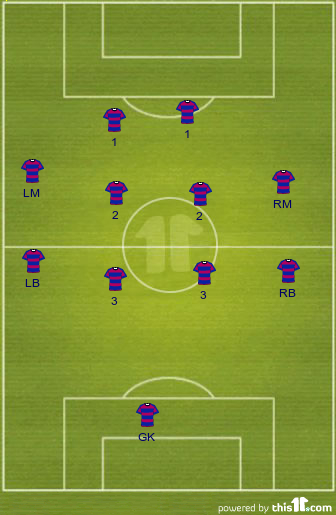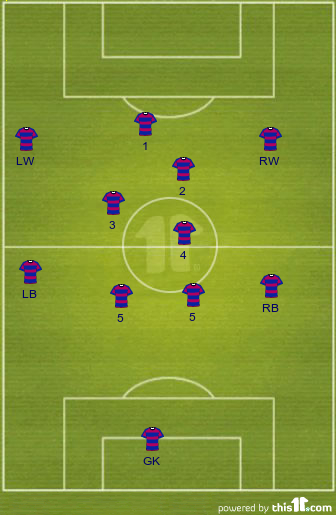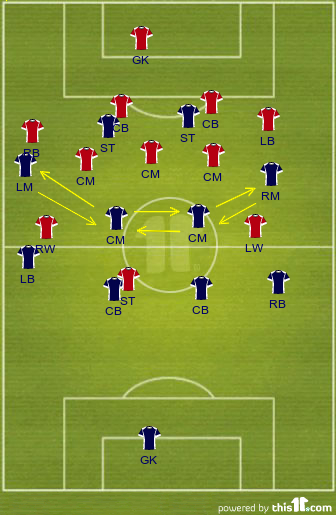So, what sets these too similar formations apart? Why is one so more effective than the other, whilst being very much alike? There are a few factors which are the answer to this question, one of them being that the 4-2-3-1 has more lines of players than the 4-4-2, this allows it to have a staggered set-up, giving a side benefits in both defence and attack.
Tactical Analysis
 Deploying
your side in a staggered system is very effective for both attacking
and defending, though the latter more so. It was used to great emphasis
by Jose Mourinho, especially in his tenure in the Chelsea hot seat.
Deploying
your side in a staggered system is very effective for both attacking
and defending, though the latter more so. It was used to great emphasis
by Jose Mourinho, especially in his tenure in the Chelsea hot seat. Despite it's effectiveness, staggered formations are often overlooked when talking about football tactics for the more exciting false 9s and such therefore, not many people think about it even though it can set aside a good system from a poor one.
It is where a team doesn't play in flat banks but more layered, positioning one player ahead or behind another whilst keeping a rough shape.
As you can see in the 4-4-2, because it hasn't got a staggered a team technically only have to get past 3 players, as since you get past one midfielder (2), you get past the whole of the midfield.
 On
the other hand, in the second diagram, a player has to get past 5
players, and if the formation uses a stopper/cover partnership in
defence, that makes it 6 players that the opposition have to get past.
On
the other hand, in the second diagram, a player has to get past 5
players, and if the formation uses a stopper/cover partnership in
defence, that makes it 6 players that the opposition have to get past.A team in a 4-4-2 can't stagger it's positions as well because they only have 3 banks of players which is the minimum a team can really have. Take the midfield duo for example, the two players alone can't cover enough ground to be effective if one pushes ahead of the other, it would still be simply overrun by a 3 man midfield which is seen in nearly every side in the modern game.
Also, if one goes into a slightly more advanced position, then the space in between the two players will be big enough for an opposition midfielder to take advantage of by finding room in the middle. In a 3 man midfield in the 4-2-3-1, the trio can assume positions on the pitch one ahead of each other whilst there not being as much space in between them. The maths explains it easier; in a 4-4-2, one central midfielder has to cover 50% of the central area of the pitch, whereas a central midfielder in a 4-2-3-1 has to cover 33% of the same area, one player can make all the difference.
Statistical Analysis - 4-4-2
For the analysis of statistics (which I have got via 'Four Four Two's Stats Zone) I have chosen to analyse Roberto Mancini's Manchester City, a side who's most used formations are the 4-2-3-1 and the 4-4-2.
The Italian manager's side set out in a 4-4-2 in their first match of the season against newly promoted side Southampton, a match which they scraped through with a 3-2 win despite being strong favourites coming in to the match.
Since they didn't have a fully staggered midfield (a striker dropped deep occasionally, but not constantly), the only good passing options for the two City central midfielders where between themselves, and to their wing (Rodwell to Silva, Toure to Nasri).
We can see this from the highest pass combinations list, Toure to Nasri, Nasri to Toure and Rodwell to Toure were the three most common at 21 each. If City dropped a striker into midfield, and staggered their midfield duo, then they would structure their attacks more effectively, and they would find it easier to attack through the middle, something which is hard to do with a 4-4-2, since there is no linking player.
Without a linking player in the hole, the strikers can get isolated up top, even from the wingers (shown in the diagram - notice how they're both cut off by the Southampton midfield). This dilemma was also indicated by the City midfielder's passing maps, I chose Silva's for the example, the Spanish number 10 rarely fails to feed the strikers with chances, however due to the top two being isolated, he found it difficult to play passes to them, this was reflected in the passing chalkboard. Notice how the majority of passes are either behind or square, to the midfielder (Rodwell) on his left and to the right back Zabaleta.
Statistical Analysis - 4-2-3-1
After 3 matches in, City have played 3 different formations; a 4-4-2, 3-5-2, and a 4-2-3-1 which the Citizens used in their latest match, a 3-1 win over QPR. They played nearly the exact same team as they did in the 4-4-2 against Southampton, but with Dzeko in for Aguero who was injured (though Dzeko came on for Aguero early in the first match).
From the player influence boards of both matches we can see that Silva and Nasri, MCFC's inside forwards, had a much larger part in the match when they had a linking player to work with.
 As you can see on the right, nearly every MCFC player's influence was a lot greater in the match against QPR (bottom diagram), despite City having a lesser possession stat than what they had in their first match. One of the reasons behind them having a higher influence is their formation, because they had two holding midfielders, they could pass out of defence much more easily, as they had two players who could collect the ball off of the centre-backs. The two holding midfielders had numerous passing options to play a ball to therefore it was easier to get all of the players involved in build up play since they received the ball from the CMs more.
As you can see on the right, nearly every MCFC player's influence was a lot greater in the match against QPR (bottom diagram), despite City having a lesser possession stat than what they had in their first match. One of the reasons behind them having a higher influence is their formation, because they had two holding midfielders, they could pass out of defence much more easily, as they had two players who could collect the ball off of the centre-backs. The two holding midfielders had numerous passing options to play a ball to therefore it was easier to get all of the players involved in build up play since they received the ball from the CMs more. In the Southampton game Tevez and Dzeko had little influence in the match, you can barely even see Tevez' name as it is hidden behind Toure's. This shows how isolated they became when surrounded by Southampton shirts, and as Tevez dropped into the hole for the QPR match, both players had a greater effect on the match (you still can't see Tevez' name for Toure's, but I assure you, it's much larger than the one in the first match).
In the Southampton game Tevez and Dzeko had little influence in the match, you can barely even see Tevez' name as it is hidden behind Toure's. This shows how isolated they became when surrounded by Southampton shirts, and as Tevez dropped into the hole for the QPR match, both players had a greater effect on the match (you still can't see Tevez' name for Toure's, but I assure you, it's much larger than the one in the first match).Along with Tevez and Dzeko, both of City's inside forwards had a greater influence as they worked together to form a front four which was responsible for 2 out of the 3 goals scored by a MCFC shirt.
Sorry for the long article and thanks for reading! Follow me on Twitter if you enjoyed this post, you can also follow the blog via email by entering your email address in the box on the top right of the page!




Hi dear,
ReplyDeleteThank you for this wonderful post. It is very informative and useful. I would like to share something here too.Oh My Football is a website for the football fans and their desire to read quality news. We are here to bring you the most interesting, fascinating and curious news from the world of football.
Antonella Roccuzzo